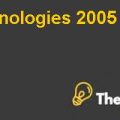
INTRODUCTION
General Motor Corporation was founded by William Durant in 1908 in Michigan. At the initial stage, the core strategy of the company was “a car for every purse and purpose.” GMC acquired Cadillac, Pontiac, Oldsmobile, Chevrolet and several auto-parts makers in the next decade. In 1920s, GMC became the market leader of automobile market with its innovative ideas and its vehicles were designed with the motive “as much fun to drive as they were to see drive”.
In 1950, GM improved its social image in society after signing two major agreements regarding health facilities and pension after retirement. This was done to win the loyalty of employees with United Automobile Workers (UAW). The United States market was completely monopolized by GM as there was no foreign competition and its domestic rivals (Ford Motor Co. (Ford) and Chrysler Corporation (Chrysler)) were compelled to follow the trend set by GM till 1960Additionally, GM was the trend setter of the automobile industry with 50 percent market share. There was technological change in automobile industry from the period 1960 to 1970 and it was a challenging tenure for the overall automobile industry. The other external factors were also affecting GM which included increasing gas prices, oil crisis, and increasing foreign competition, especially from Japan. This was the time of re-engineering, in 1974 GM came with an innovative technology that was the catalytic converter, and it became the benchmark for the global auto industry. Before mid nineties, GM was a de-centralized organization. However, its global functions were autonomously operated and in 1990s GM started to convert into a centralized organization.
Opel was established in 1862 by Adam Opel near Frankfurt, Germany. It is a sign of proud for German nation as it was a German brand because of its long success history in International market. Opel was acquired by GM in 1929 and it became a subsidiary of GM. It was the Opel, which helped the GM to penetrate in the global market. 15 different models and Vauxhall in UK market with 14 models; these were the key success factors that turned Opel as GM’s core brand. Recent global financial crisis also hit the automotive market like other sectors of automotive industry were also in phase of change. Demands were lower than supply these were the major concerns for industry.
A report from Standard and Poor in 2009 estimated that worldwide sales of automakers for the year 2010 would decrease. Such a severe recession with exceeding supply than demand and low capacity utilization indirectly increased firms’ costs. Profits of industry were continuously decreasing.
During 2008, major automakers were improving their liquidity position with the help of their respective government by taking loans and injecting cash so as to improve their financial position. The interests of governments were also attached with automakers as they were the major source of job creation. To improve sales of automobiles, in 2009 the US government introduced a scheme like “cash for clunkers”. The main idea was to motivate consumers to replace their old cars with new cars and get cash in response incentive (of either $3,500 or $4,500 depending upon the category) for new cars that were fuel efficient. The other governments of Canada, China, Germany and France also introduced similar programs. Toyota was the on the top of the list that nurtured the advantage of scheme like “cash for clunkers” with 19 percent of overall 690000 new vehicles were sold under the offer. Because of severe financial position as discussed above, Opel was also affected like other automobile makers, and more especially crisis hit severely its parent GM. Opel had recorded losses during every year of the 2000s, excepting 2001 and 2002. It had accumulated losses of €1.861 billion ($2.647 billion) from 2003 to 2004. Opel's market share had come down from 13.7 per cent in 1999 to 8.4 per cent in 2008.
German government was very vigilant about the future of Opel as it was the sign of proud for Germans. In 2009, GM Europe demanded for emergency loan package of $4.2 billion from European governments in order to rescue the operation of Opel. The new board of GM was appointed by US government after bailout package. Additionally, they were interested to retain Opel not only because of Intellectual Property Rights (IPR) but also the Opel had competitive advantage in technology of medium-sized automobiles. Europe and North America were the potential growing markets for medium-sized vehicles. It was the Opel that could only secure the product and technology momentum, which was necessary to position the “new” GM for growth and profitability in the global automotive industry.
PROBLEM STATEMENT
After the global financial crisis, General Motor Corporation was suffering financial losses, which threatened the survival of GM. It was producing cars and trucks in 34 countries. It had 209,000 employees worldwide, and GM did business in 140 countries. North America and Europe were the largest markets. The company had revenues of $148.9 billion and a loss of $30.9 billion for the year ending December 2008. Its liabilities on December 31, 2008, were $176.1 billion, against assets of $91.0 billion....................
This is just a sample partial case solution. Please place the order on the website to order your own originally done case solution.
In July 2009, General Motors (GM), the second-largest automotive company, emerged from bankruptcy organized by the U.S. federal government. Compact and focused after a 40-day exercise, GM is still far from a full financial recovery. The company is under a mandate to focus primarily on its U.S. market. Its European subsidiary, which produces Opel cars, fighting for nearly a decade. Business seems to be fundamentally sound. Opel needs a capital injection and management skills, for which GM is in talks with potential investors such as Fiat in Italy, BAIC China, Magna of Canada and RHJI Belgium. Board GM has to decide, GM should eliminate Opel, store it in the numbers, or go for a partial exclusion. In the case of the sale of shares, the board must decide who, from among those shortlisted for the CEO and his team, he should bring on board. The case allows students to use available data and their decision to choose a candidate who can drive shareholder value. It helps them deal with issues such as the timing and prejudice in a typical store / liquidation / deny decisions, and whether the company should be on the lines of most M & Strategy, the current strategy of privatization. "Hide
by Ramasastry Chandrasekhar, Darren Meister Source: Richard Ivey School of Business Foundation 19 pages. Publication Date: Mar 08, 2010. Prod. #: 910M22-PDF-ENG













